【LeetCode-SQL专项突破】-第10天:过滤
📢📢📢📣📣📣
哈喽!大家好,我是【IT邦德】,江湖人称jeames007,10年DBA工作经验
一位上进心十足的【大数据领域博主】!😜😜😜
中国DBA联盟(ACDU)成员,目前从事DBA及程序编程
擅长主流数据Oracle、MySQL、PG 运维开发,备份恢复,安装迁移,性能优化、故障应急处理等。
✨ 如果有对【数据库】感兴趣的【小可爱】,欢迎关注【IT邦德】💞💞💞
❤️❤️❤️感谢各位大可爱小可爱!❤️❤️❤️
文章目录
- 前言
-
- 182.查找重复的电子邮箱
- 1050. 合作过至少三次的演员和导演
- 1587.银行账户概要 II
- 1084. 销售分析III
前言
SQL每个人都要用,但是用来衡量产出的并不是SQL本身,你需要用这个工具,去创造其它的价值。
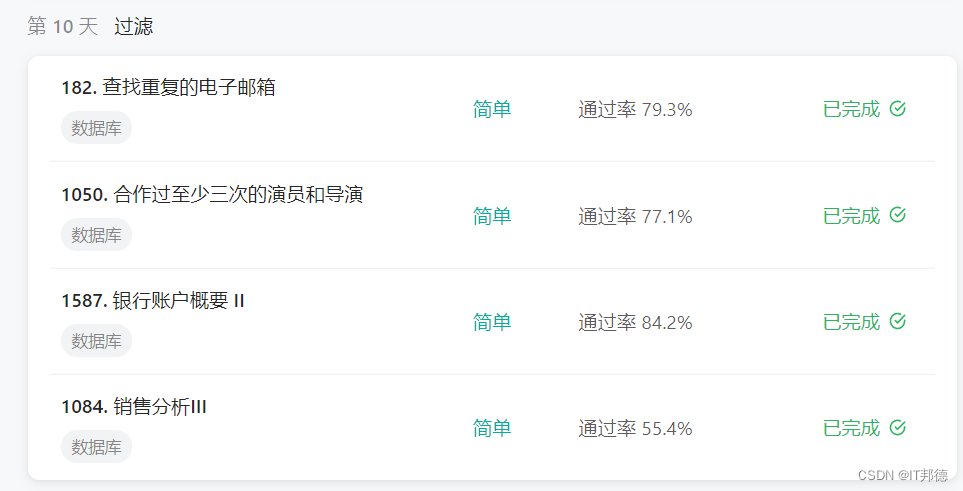
182.查找重复的电子邮箱
🚀 编写一个 SQL 查询,查找 Person 表中所有重复的电子邮箱。示例:+----+---------+| Id | Email |+----+---------+| 1 | a@b.com || 2 | c@d.com || 3 | a@b.com |+----+---------+根据以上输入,你的查询应返回以下结果:+---------+| Email |+---------+| a@b.com |+---------+说明:所有电子邮箱都是小写字母。🐴🐴 答案# Write your MySQL query statement belowselect Email from Persongroup by Emailhaving count(*)>1/* Write your T-SQL query statement below */select distinct(p1.Email) Email from Person p1 join Person p2 on p1.Email = p2.Email AND p1.Id!=p2.Id/* Write your PL/SQL query statement below */select Email "Email" from( select Email,count(Email) as num from Person group by Email) where num>1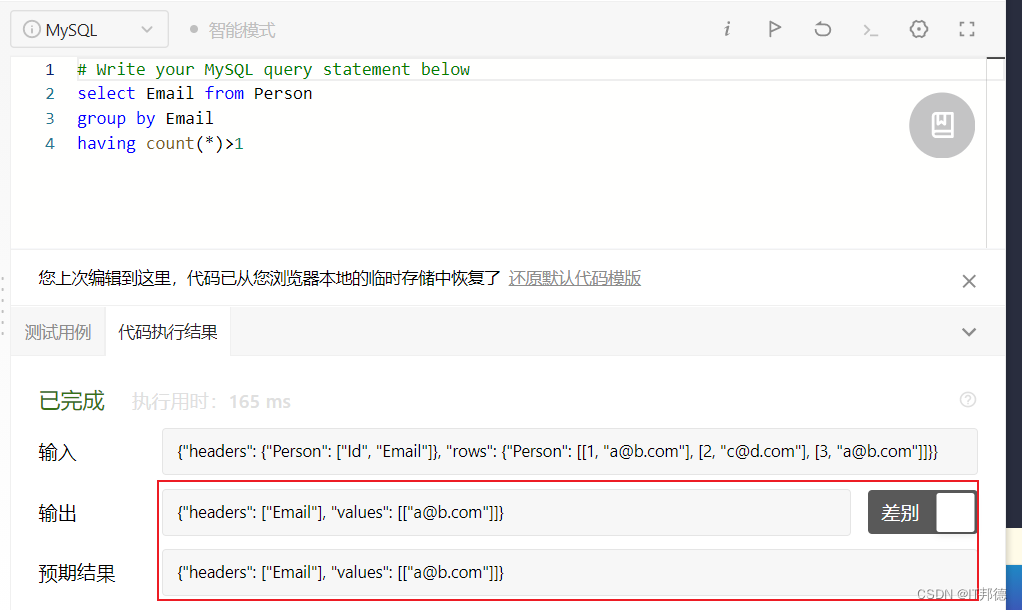
1050. 合作过至少三次的演员和导演
🚀 ActorDirector 表:+-------------+---------+| Column Name | Type |+-------------+---------+| actor_id | int || director_id | int || timestamp | int |+-------------+---------+timestamp 是这张表的主键.🚀 需求写一条SQL查询语句获取合作过至少三次的演员和导演的 id 对 (actor_id, director_id)示例:ActorDirector 表:+-------------+-------------+-------------+| actor_id | director_id | timestamp |+-------------+-------------+-------------+| 1 | 1 | 0 || 1 | 1 | 1 || 1 | 1 | 2 || 1 | 2 | 3 || 1 | 2 | 4 || 2 | 1 | 5 || 2 | 1 | 6 |+-------------+-------------+-------------+Result 表:+-------------+-------------+| actor_id | director_id |+-------------+-------------+| 1 | 1 |+-------------+-------------+唯一的 id 对是 (1, 1),他们恰好合作了 3 次。 🐴🐴 答案# Write your MySQL query statement belowselect actor_id,director_idfrom ActorDirectorgroup by actor_id,director_idhaving count(timestamp)>=3/* Write your T-SQL query statement below */select actor_id,director_idfrom ActorDirectorgroup by actor_id,director_idhaving count(timestamp)>=3/* Write your PL/SQL query statement below */select actor_id "actor_id",director_id "director_id"from ActorDirectorgroup by actor_id,director_idhaving count(*) > =3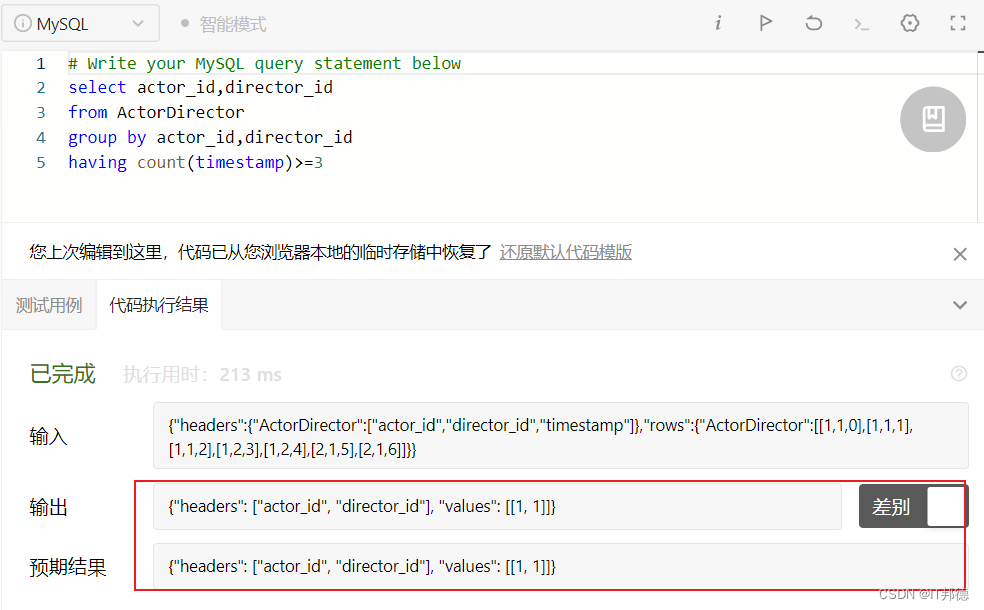
1587.银行账户概要 II
🚀 表: Users+--------------+---------+| Column Name | Type |+--------------+---------+| account | int || name | varchar |+--------------+---------+account 是该表的主键.表中的每一行包含银行里中每一个用户的账号. 🚀 需求表: Transactions+---------------+---------+| Column Name | Type |+---------------+---------+| trans_id | int || account| int || amount | int || transacted_on | date |+---------------+---------+trans_id 是该表主键.该表的每一行包含了所有账户的交易改变情况.如果用户收到了钱, 那么金额是正的; 如果用户转了钱, 那么金额是负的.所有账户的起始余额为 0.写一个 SQL, 报告余额高于 10000 的所有用户的名字和余额. 账户的余额等于包含该账户的所有交易的总和.返回结果表单没有顺序要求.查询结果格式如下例所示.Users table:+------------+--------------+| account | name |+------------+--------------+| 900001 | Alice || 900002 | Bob || 900003 | Charlie |+------------+--------------+Transactions table:+------------+------------+------------+---------------+| trans_id | account | amount | transacted_on |+------------+------------+------------+---------------+| 1 | 900001 | 7000| 2020-08-01 || 2 | 900001 | 7000| 2020-09-01 || 3 | 900001 | -3000 | 2020-09-02 || 4 | 900002 | 1000| 2020-09-12 || 5 | 900003 | 6000| 2020-08-07 || 6 | 900003 | 6000| 2020-09-07 || 7 | 900003 | -4000 | 2020-09-11 |+------------+------------+------------+---------------+Result table:+------------+------------+| name| balance |+------------+------------+| Alice | 11000 |+------------+------------+Alice 的余额为(7000 + 7000 - 3000) = 11000.Bob 的余额为1000.Charlie 的余额为(6000 + 6000 - 4000) = 8000.🐴🐴 答案# Write your MySQL query statement belowWITH t AS (SELECT account, SUM(amount) balance FROM Transactions GROUP BY account HAVING SUM(amount)>10000)SELECT name, balanceFROM t JOIN Users USING(account)/* Write your T-SQL query statement below */selectname,sum(isnull(b.amount, 0)) balance from Users aleft join Transactions bon a.account = b. accountgroup by namehaving sum(isnull(b.amount, 0))>10000/* Write your PL/SQL query statement below */selectname,sum(nvl(b.amount, 0)) balance from Users aleft join Transactions bon a.account = b. accountgroup by namehaving sum(nvl(b.amount, 0))>10000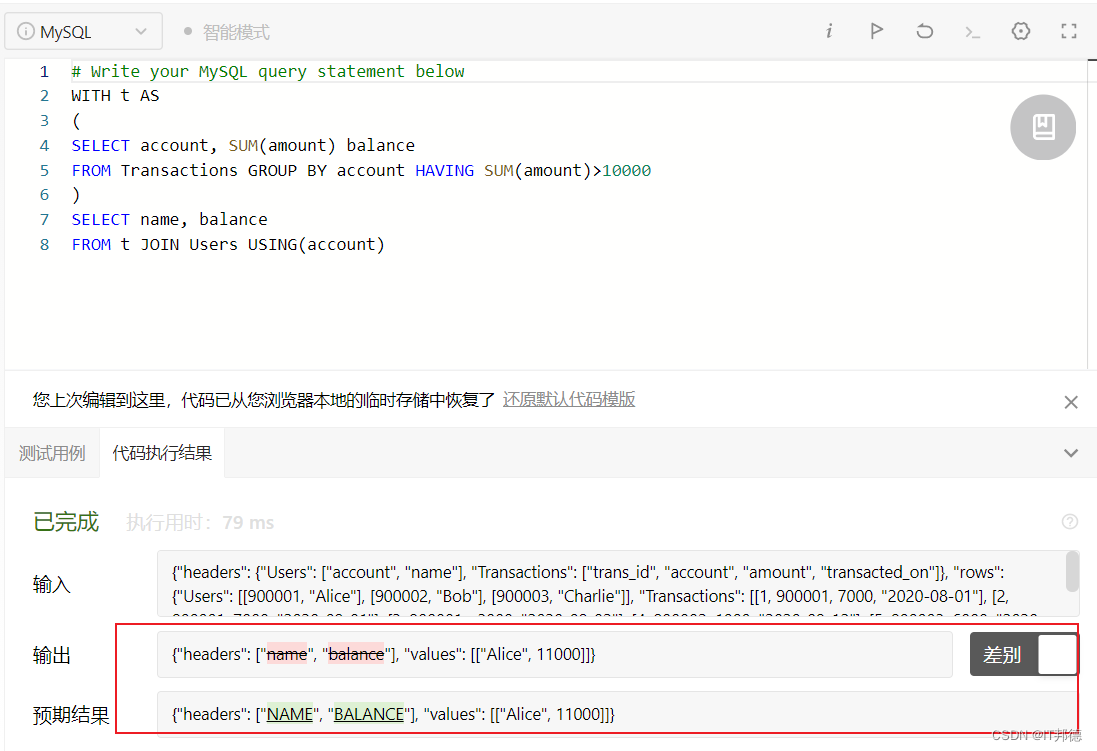
1084. 销售分析III
🚀 Table: Product+--------------+---------+| Column Name | Type |+--------------+---------+| product_id | int || product_name | varchar || unit_price | int |+--------------+---------+Product_id是该表的主键。该表的每一行显示每个产品的名称和价格。Table: Sales+-------------+---------+| Column Name | Type |+-------------+---------+| seller_id | int || product_id | int || buyer_id | int || sale_date | date || quantity | int || price| int |+------ ------+---------+这个表没有主键,它可以有重复的行。product_id 是 Product 表的外键。该表的每一行包含关于一个销售的一些信息。🚀 需求编写一个SQL查询,报告2019年春季才售出的产品。即仅在2019-01-01至2019-03-31(含)之间出售的商品。以任意顺序 返回结果表。查询结果格式如下所示。示例 1:输入:Product table:+------------+--------------+------------+| product_id | product_name | unit_price |+------------+--------------+------------+| 1 | S8 | 1000|| 2 | G4 | 800 || 3 | iPhone| 1400|+------------+--------------+------------+Sales table:+-----------+------------+----------+------------+----------+-------+| seller_id | product_id | buyer_id | sale_date | quantity | price |+-----------+------------+----------+------------+----------+-------+| 1 | 1 | 1 | 2019-01-21 | 2 | 2000 || 1 | 2 | 2 | 2019-02-17 | 1 | 800 || 2 | 2 | 3 | 2019-06-02 | 1 | 800 || 3 | 3 | 4 | 2019-05-13 | 2 | 2800 |+-----------+------------+----------+------------+----------+-------+输出:+-------------+--------------+| product_id | product_name |+-------------+--------------+| 1 | S8 |+-------------+--------------+解释:id为1的产品仅在2019年春季销售。id为2的产品在2019年春季销售,但也在2019年春季之后销售。id为3的产品在2019年春季之后销售。我们只返回产品1,因为它是2019年春季才销售的产品。🐴🐴 答案# Write your MySQL query statement belowselect p.product_id, p.product_namefrom Product p, Sales swhere p.product_id = s.product_idgroup by p.product_id, p.product_namehaving(sum(sale_date between '2019-01-01' and '2019-03-31') = count(*))/* Write your T-SQL query statement below */SELECT s.product_id , product_nameFROM Sales s JOIN Product pON s.product_id = p.product_idGROUP BY s.product_id,product_nameHAVING MIN(sale_date) >= '2019-01-01' AND MAX(sale_date) <= '2019-03-31'/* Write your PL/SQL query statement below */SELECT s.product_id "product_id", product_name "product_name"FROM Sales s JOIN Product pON s.product_id = p.product_idGROUP BY s.product_id,product_nameHAVING MIN(sale_date) >= '2019-01-01' AND MAX(sale_date) <= '2019-03-31'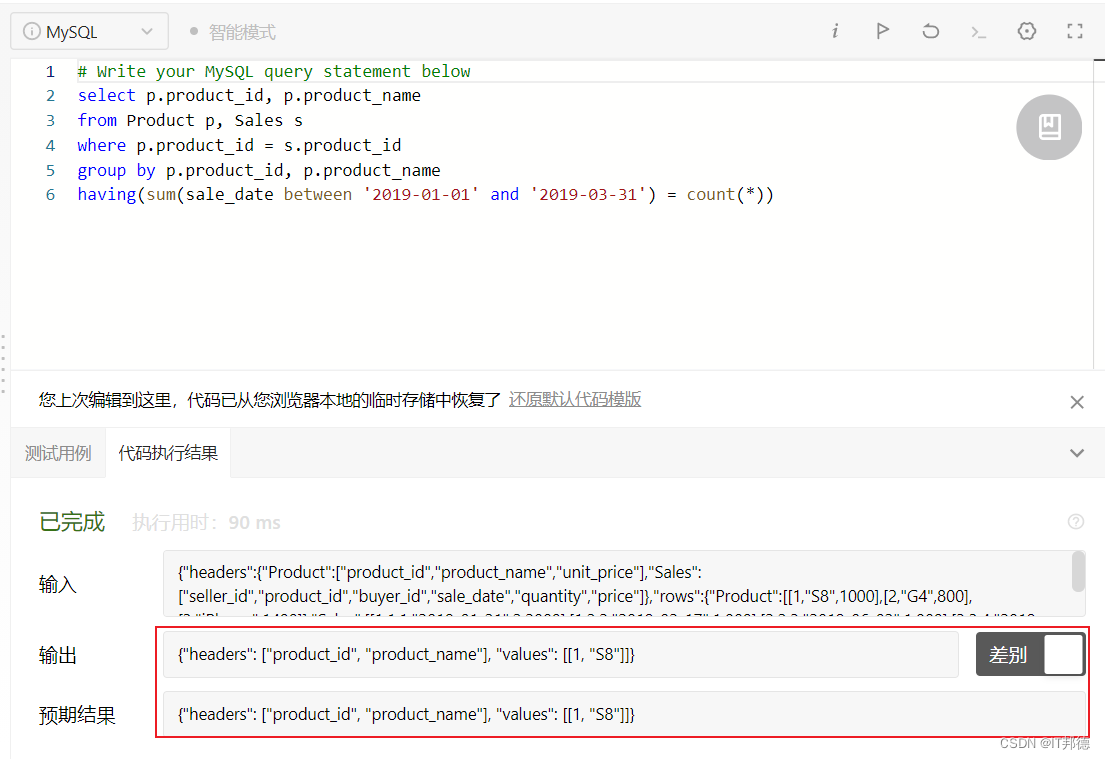
体系化学习SQL,请关注CSDN博客
https://blog.csdn.net/weixin_41645135/category_11653817.html



